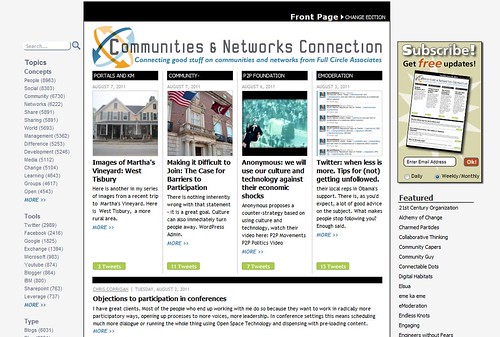Last Monday I was a guest of the Leadership Learning Community for an short online gathering. The description was pretty loose and they expected around 50 people to show up.
Communities, Networks and Engagement: Finding a Place for Action
We have so many online tools at our disposal to theoretically connect and activate engagement with others. But what happens when we say “we’re building an online community” but few engage? When is it worth the work and effort? What are our options? And if we build it, what are some starting points to help us work towards successful engagement?
We were using a GoToWebinar platform, which I’ll admit, I don’t like because it is really a broadcast tool, with no peer to peer interaction and all participant interaction funneled to one person (and there were four of us involved in producing the event, so lots of forwarding, etc.) I decided to abandon a more formal presentation style to try and engage people from the start because after all, this was what the webinar was about! So we started with some polls, and then with my host, Grady McGonagill, we took questions during the presentation and Grady and I diverged into conversation as well. Consequently, I did not get through the material. So I promised to follow up with the slides, resources and answers to any outstanding questions we did not get to. Thus this blog post. Here we go…
Questions
- Any tips or recommended resources for facilitating hybrid online/phone focus groups with smaller groups (5-15 max)? Also, any recommendations re: optimal group size for this sort of interaction? If the group is all online – you are lucky. The most challenging groups are mixed online and offline. For facilitating, there are a couple of things to keep in mind. 1) Think multi-modality. Audio alone doesn’t work well for a lot of us to stay engaged. Have a visual element – a shared Google doc or presentation, a wiki/chat room in Meetingwords.com or use the white board in a web meeting tool. Of course, this visual aspect needs to be relevant. I really like pairing chat rooms w/ audio (be it on phone, skype or whatever) where people can talk to each other without having to wait for audio “air time.” This does challenge some people who are less comfortable multitasking. You might consider methods like “the clock” both for phone and web meetings (see here and here). 2) Think 7 minute chunks. Break things up alternating content sharing with interacting, visual with audio. Remember, it is hard to pay attention when our bodies are not in the same place. 3) Group size issues are similar to those F2F. Once you get over 5 or 6 it is harder for everyone to have a chance to speak up. With some web tools, you can do break out rooms — just like F2F!
- How do you balance “quality control” with network engagement/ participation/ responsibility? I was very intrigued by this question. It is probably helpful to figure out what we mean by quality control. I’ll take a guess and someone chime in if I get it wrong. I’m assuming this is about content — did a member give correct or useful advice. Was the data shared accurate, etc. My experience is that in communities where people care about what they are working with (the “domain”) they also care about quality and help weed out the “iffy” stuff. The key is to cultivate habits of critical thinking and useful practices to apply that thinking (which means civility!) If we are talking about “quality people” I’m assuming this means attracting people who know something about the domain. Again, if the learning matters, you will attract good people. It can feel, however, like a leap of faith. One word? LEAP!
- We have persons in developing countries as well as in places where the internet is not an issue… this produces a big challenge to overcome to connect the majority of them. How do you engage them? How do you make them feel part of the community (normally they believe and put money, but not always participate). Again, I need to be careful in my interpretation of this question! When we work globally, we have both similarities and differences to account for. First, if there is clarity on shared domain (what the group is interested in an how it is concretely relevant to them today!) you are ahead of the game. Many global communities I’ve been involved with have very broad, generic domains. While no one could disagree with them, they were so broad everyone deprioritized their participation. A big tent may hold many people, but a big tent can also be empty. Consider focusing the domain in a way that carries relevance for people NOW. Then make the tent bigger later. Second, cultural diversity (linguistic, national, professional, gender, etc.) can be harder to detect online, but can trip us up faster. I find making these differences discuss-able little bit by little bit helps. Encourage people to share their ways of working and interacting. Compare and contrast a bit. This helps people find common ground and know when to “cut some slack” for others’ behaviors which they may not — ahem — love themselves! Finally, talk about participation — don’t assume it. Ask for small, doable things from people to build that sense of and experience of engagement. Don’t ask for TOO much — people are busy no matter where they live! Small bites are tasty! (See also the next two questions)
- Do you have any recommendations for technology when your community is spread around the world? In my experience where bandwidth and electricity are limiting elements the most effective technology is email based technology. The use of text on mobile phones is the first technology that might unseat email. There are also community rhythm issues when you have people coming from diverse bandwidth contexts. For example, when you have a mix of folks who are “always online and reply quickly to messages AND people who are online once a week or every two weeks, you can get a lot of asymmetry in participation with those on less feeling left out and “late to the party.” If this happens to you, encourage the always-on folks to slow down. It’s good practice for us “fast fast fast” people!
- What does diversity mean in this discussion? How does class diversity and online access play a role? How do multilingual networks connect and thrive? What hosting platform handles multilingual groups best? Diversity means MANY things and some have different implications than others. Lets start with linguistic diversity. I have used platforms that have multilingual interfaces — and which one will work for you depends on what languages you need. But the user interface is just step one. That helps people get online. But the key is having a) critical mass within each linguistic group for ongoing interaction and b) “bridgers” who help summarize and translate. I’ve blogged a bit about this issue and you can read some of the articles here.
- Can you repeat at some point how to access the wiki? I mentioned two wikis. One was my online facilitation resources wiki here. The other is the Knowledge Sharing Toolkit, a collaborative effort to capture a variety of online and offline methods.
- CPsquare doesn’t give much on their initial website — any chance you all can give more guidance on how to connect to it? It is hard to get a sense of all the wonderful things that happen around CP2. First, it is important to know it is a membership community. You can see the blog for free, but ya gotta join, ok? For example, there is the quarterly “Foundations of Communities of Practice” online workshop which is a deep dive into CoPs. John Smith, the community steward, told me to mention”help in real time” which is a discussion board for Q&A with fabulous people resources, the month telecon on “shadow the leader” where the community hears about the community leadership practices of one person over the arc of a year (currently Marc Coenders on evolving his evolving business model), the R&D series on student projects where mostly PhD candidates support each other and then when drafts of work are ready, the community offers feedback. For more details, read CP2 blog for news and updates. My shorthand? CP2 is a place to engage with others who care about communities of practice!
Have other questions or thoughts? Chime in with a comment.
Slides:

